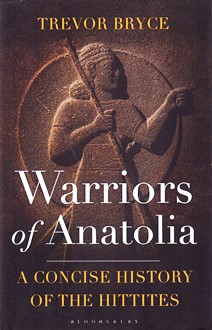Warriors of Anatolia : a concise history of the Hittites / Trevor Bryce.
Yer Numarası
A.IX/0874
ISBN
9781350140783
9781786735287 (ePDF)
9781786735288 (eBook)
9781786735287 (ePDF)
9781786735288 (eBook)
Dil Kodu
İngilizce
Yayın Bilgisi
London : Bloomsbury Academic, 2019.
Fiziksel Niteleme
xi, 288 sayfa : resim, harita ; 22 cm
Genel Not
İndeks s. [282]-288.
Bibliyografi, vb. Notu
Bibliyografya s. [280]-281.
İçindekiler Notu
List of Maps and Figures -- Acknowledgements -- Introduction -- Chapter 1. Rediscovering a Lost World -- Chapter 2. How Do The Hittites Tell Us About Themselves? -- Chapter 3. The Dawn of the Hittite Era -- Chapter 4. The Legacy of an Ailing King -- Chapter 5. 'Now Bloodshed Has Become Common' -- Chapter 6. The Setting for an Empire -- Chapter 7. Building an Empire -- Chapter 8. Lion or Pussycat? -- Chapter 9. From Near Extinction to the Threshold of International Supremacy -- Chapter 10. The Greatest Kingdom of Them All -- Chapter 11. Intermediaries of the Gods: The Great Kings of Hatti -- Chapter 12. King by Default -- Chapter 13. Health, Hygiene and Healing -- Chapter 14. Justice and the Commoner -- Chapter 15. No Sex Please, We're Hittite -- Chapter 16. Women, Marriage and Slavery -- Chapter 17. War with Egypt -- Chapter 18. All the King's Horses and All the King's Men -- Chapter 19. The Man Who Would Be King -- Chapter 20. Partners in Power: The Great Queens of Hatti -- Chapter 21. City of Temples and Bureaucrats: The Royal Capital -- Chapter 22. An Elite Fraternity: the Club of Royal Brothers -- Chapter 23. The Empire's Struggle for Survival -- Chapter 24. Hatti's Divine Overlords -- Chapter 25. Death of an Empire -- Appendix 1. Rulers of Hatti -- Appendix 2. Outline of Main Events in Hittite History -- Notes -- Select Bibliography -- Index.
Özet, vb.
“In this lively treatment of one of antiquity's most mysterious civilizations, whose history disappeared from the records over 3,000 years ago, Trevor Bryce sheds fresh light on Hittite warriors as well as on the Hittites' social, religious and political culture and offers new solutions to many unsolved questions. Revealing them to have been masters of chariot warfare, who almost inflicted a disastrous defeat on Rameses II at the Battle of Qadesh (1274 BCE), he shows the Hittites also to have been devout worshippers of a pantheon of storm-gods and many other gods, and masters of a new diplomatic system which bolstered their authority for centuries. Drawing authoritatively both on texts and on ongoing archaeological discoveries, while at the same time offering imaginative reconstructions of the Hittite world, Bryce argues that while the development of a warrior culture was essential, not only for the Empire's expansion but for its very survival, this by itself was not enough. The range of skills demanded of the Hittite ruling class went way beyond mere military prowess, while there was much more to the Hittites themselves than just skill in warfare. This engaging volume reveals the Hittites in their full complexity, including the festivals they celebrated; the temples and palaces they built; their customs and superstitions; the crimes they committed; their social hierarchy, from king to slave; and the marriages and pre-nuptial agreements they contracted. It takes the reader on a journey which combines epic grandeur, spectacle and pageantry with an understanding of the intimacies and idiosyncrasies of Hittite daily life” -- Yayıncı.


